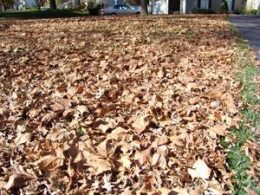 Everywhere I go I see leaves on the ground or in bags. The good thing is we don’t have to send all of our fallen leaves to the landfill but instead we can compost them at home and use in the garden later. Compost is a great addition to any garden! How is the composting process accomplished?
Everywhere I go I see leaves on the ground or in bags. The good thing is we don’t have to send all of our fallen leaves to the landfill but instead we can compost them at home and use in the garden later. Compost is a great addition to any garden! How is the composting process accomplished?
Microorganisms and small invertebrates account for most of the decomposition that takes place within the compost pile. With the required oxygen and water, these organisms break down yard and food wastes, producing carbon dioxide, heat, water, and soil-enriching compost in the process.
One way to determine success is to monitor pile temperature. During composting, the pile warms to 150° to 160° F. and gradually returns to ambient temperatures after organic materials decompose. Warm temperatures increase water evaporation. A decrease in the pile’s weight and volume is another way to measure composting effectiveness. Decomposing organisms include naturally occuring bacteria, fungi, and molds, and small invertebrate animals such as mites, millipedes, insects, and earthworms. With a wide range of organisms, there is a better chance that composted materials will be broken down completely. Aerobic bacteria, which require oxygen, are the most important decomposers in the compost pile.
Aerobic vs. Anaerobic Organisms
Aerobic organisms are preferred because they provide rapid and complete composting. Other organisms can operate without oxygen or in anaerobic conditions. This process, sometimes called fermentation, occurs more slowly. The biggest problem with anaerobic organisms is the tendency to produce offensive odors. They also generate acids and alcohols that can harm
certain plants. A bad smell coming from the compost pile usually means it needs more oxygen, and it is time to turn or agitate the pile.
Temperature
Aerobic bacteria vary in their ability to tolerate certain temperatures. Thermophilic bacteria survive at 140° to 150° F. At the beginning of the composting process, bacteria adapted to lower temperatures predominate. When temperatures reach a certain level, these bacteria die, and thermophilic bacteria take over.
Thermophilic bacteria, too, eventually succumb to the increasing temperatures. When this happens, the pile temperature begins to drop, and bacteria suited to lower temperatures take over. Bacteria die after most of the material has been composted. When energy has been depleted, the composting process is complete.
Biological Activity
The complex web of life in the compost pile includes organisms that feed on organic materials or other organisms. Mobile organisms such as worms may move away from the excessive heat at the center of the pile, and then move back again when the pile cools. Most harmful organisms, such as disease organisms or persistent insect pests, as well as weed seeds, are killed in the composting process.
Compost Activators
Decomposition of organic materials is carried out by bacteria and fungi that occur naturally in the environment. Soil can be added to the compost pile to increase the number of microorganisms. For populations to build, organisms need nitrogen, which can be supplied with an activator material. If you are trying to compost mostly brown materials such as leaves or wood chips, you should supplement with nitrogen from either a commercial fertilizer or a natural source. Natural materials containing nitrogen include blood meal, finished compost, fish meal, manure, or alfalfa meal.
Application Procedures
The amount of activator to add depends on the concentration of nitrogen in the activator material. For concentrated materials such as commercial fertilizer, 1 to 2 cups of fertilizer per 10 square feet of compost bed area should be sufficient. If adding blood meal, alfalfa meal, or concentrated manure, add 1 to 2 pounds per 10 square feet of compost bed area. If using compost, 4 to 5 pounds per 10 square feet of compost pile area is recommended.
After applying the activator, continue to build the pile by adding 6 to 8 inches of organic material, a light sprinkling of 1⁄2 to 1 inch of soil, followed by another activator application. When finished, moisten the pile, blending contents with a pitchfork or rake to speed decomposition. The nutrient in the activator is absorbed into the bodies of the microorganisms as they build in large populations to break down organic materials in the compost. After the composting process is complete, these nutrients, plus any additional nutrients available in organic materials, are released back into the compost as the microorganisms die. This accounts for the high-nutrient value of a well-made compost.
Other Considerations
You can buy products known as compost activators, which contain the fungi and bacteria necessary to start the composting process. Purchasing these types of activators is not necessary if you can use garden soil, which contains a wide range of these natural organisms. If you prefer to buy activators rather than adding soil, follow the label directions on how much activator to add per unit of compost volume or area.
